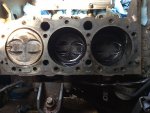Regal1973
Petty Officer 2nd Class
- Joined
- Feb 15, 2018
- Messages
- 106
For the ones who were following my last topic of a VP with idle issues, I was chasing symptoms which finally lead me to this..... I believe I've now found the real issue......WATER IN CYLINDERS


This diagnosis finally came about after replacing the starter twice and having the same result of grinding noise on flywheel / no motor run.
Thanks to all who have offered help & suggestions, but now I feel it's a bit more serious an issue that a simple sensors, ignition etc
Back history: Just purchased boat with VP 5.7L GI MULTIPORT INJECTION less than 200 hours. Sea trial was only time boat ran without a hitch...every time since then (2 attempts to go out) have had issue with it stalling when idling. Messed with iac, distributor, new fuel & then it stranded us with grinding starter sound. Tried new starter with same result, no start , grinding noise..... now I find water in cylinders.
Water has been in cylinders for 6 days.
What I've done thus far: Disconnected kill switch, shut batteries off, pulled coil wire. Pulled the spark plugs late last night, FLOODED cylinders with seafoam fogger oil ( I did not turn motor over due to it being so late at night). 3 cylinders on starboard had water. One cylinder on port side with water.
Also ended up breaking a spark plug off. The porcelain and hex came out in one piece, leaving the threaded part in head. I guess I now have to try and use an "easy out".....just one more thing to deal with

Today I'll try and turn motor over, flush out water and re-fog cylinders with oil.
Once I do that, should I reinstall plugs and turn it over to see if I hear anything out of the norm? How will I know if I might have slightly bent or damaged anything by trying to start it multiple times. The motor ever so slightly did try to turn when starter would engage flywheel but never fully turned......starter would just kick back and grind on flywheel.
Anyone recommended in the Tampa Bay Florida area who is reputable, honest, capable of diagnosing the issue, evaluating the current condition of engine and on whether I can make out with a new exhaust system (if that is the issue) or the dreaded worst case, a new motor installed
If new motor is needed, anyone have my suggestions on quality replacement, reasonably priced with emphasis on good warranty. Guessing I would more than likely be able to get by with a short block if I need to go motor route.
Thanks to all for any info.
This diagnosis finally came about after replacing the starter twice and having the same result of grinding noise on flywheel / no motor run.
Thanks to all who have offered help & suggestions, but now I feel it's a bit more serious an issue that a simple sensors, ignition etc
Back history: Just purchased boat with VP 5.7L GI MULTIPORT INJECTION less than 200 hours. Sea trial was only time boat ran without a hitch...every time since then (2 attempts to go out) have had issue with it stalling when idling. Messed with iac, distributor, new fuel & then it stranded us with grinding starter sound. Tried new starter with same result, no start , grinding noise..... now I find water in cylinders.
Water has been in cylinders for 6 days.
What I've done thus far: Disconnected kill switch, shut batteries off, pulled coil wire. Pulled the spark plugs late last night, FLOODED cylinders with seafoam fogger oil ( I did not turn motor over due to it being so late at night). 3 cylinders on starboard had water. One cylinder on port side with water.
Also ended up breaking a spark plug off. The porcelain and hex came out in one piece, leaving the threaded part in head. I guess I now have to try and use an "easy out".....just one more thing to deal with
Today I'll try and turn motor over, flush out water and re-fog cylinders with oil.
Once I do that, should I reinstall plugs and turn it over to see if I hear anything out of the norm? How will I know if I might have slightly bent or damaged anything by trying to start it multiple times. The motor ever so slightly did try to turn when starter would engage flywheel but never fully turned......starter would just kick back and grind on flywheel.
Anyone recommended in the Tampa Bay Florida area who is reputable, honest, capable of diagnosing the issue, evaluating the current condition of engine and on whether I can make out with a new exhaust system (if that is the issue) or the dreaded worst case, a new motor installed
If new motor is needed, anyone have my suggestions on quality replacement, reasonably priced with emphasis on good warranty. Guessing I would more than likely be able to get by with a short block if I need to go motor route.
Thanks to all for any info.
Last edited:





















